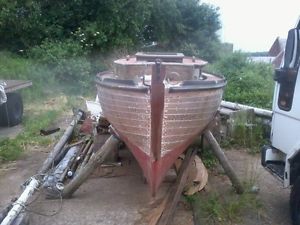Back to the main page Back to category Sailing Boats
boat details
Itchen Ferry Cutter
Estimated price for orientation: 500 $
Category: Sailing Boats
Class:
Description Year: 1907 Hull Material: Oak Length (feet): 18 Rigging: All present Beam (feet): 7 Keel: Lead
The Itchen Ferry boat ( also known as the Itchen Ferry cutter, Itchen Ferry punt, Itchen Ferry smack, Itchen Hoy or Itchen punt ) is a workboat of the Solent area, Southern England. The first vessels built originated on the River Itchen in the 18th century, initially as the small Itchen Ferry punt.
With a LOA. of between 18 and 30ft, both the punt and the larger Itchen Ferry cutter ( or smack ) trawled for fish and shrimp, dredged oysters, transported passengers, and were raced.
A few of the very early boats were reportedly clinker-built but moved almost exclusively to carvel by 1850s. A soft turn of the bilges, slight tumble home to topsides and a low sheer formed the attractive lines of these pretty workboats. Other notable features were a plumb stem with a rounded foot and a slightly raked, wineglass transom.
An outboard rudder with a wide blade below the waterline and a tiller helm. The cutters were decked to just abaft the pole mast with wide side decks and a fish tray set aft, slightly below the gunwhales for the nets and fish-sorting. A small cuddy forward providing just enough room for sails and a few other essentials. Most of the boats employed internal ballast but later opted for a ballast keel, such as an iron keel shoe. The topsides were traditionally grey or black.
The cutters originally had a long gaff that created a nearly vertical leech to the boomless mainsail; later the gaff was shorter and the sail had a boom that extended well beyond the stern. Staysail originally tacked to the stemhead, then to an iron bumkin, and then a long, running bowsprit was added to which a jib was run out on a traveler. Topsail sent up on a pole mast for racing.
Description
| Year: | 1907 | Hull Material: | Oak |
| Length (feet): | 18 | Rigging: | All present |
| Beam (feet): | 7 | Keel: | Lead |
The Itchen Ferry boat ( also known as the Itchen Ferry cutter, Itchen Ferry punt, Itchen Ferry smack, Itchen Hoy or Itchen punt ) is a workboat of the Solent area, Southern England. The first vessels built originated on the River Itchen in the 18th century, initially as the small Itchen Ferry punt.
With a LOA. of between 18 and 30ft, both the punt and the larger Itchen Ferry cutter ( or smack ) trawled for fish and shrimp, dredged oysters, transported passengers, and were raced.
A few of the very early boats were reportedly clinker-built but moved almost exclusively to carvel by 1850s. A soft turn of the bilges, slight tumble home to topsides and a low sheer formed the attractive lines of these pretty workboats. Other notable features were a plumb stem with a rounded foot and a slightly raked, wineglass transom. An outboard rudder with a wide blade below the waterline and a tiller helm. The cutters were decked to just abaft the pole mast with wide side decks and a fish tray set aft, slightly below the gunwhales for the nets and fish-sorting. A small cuddy forward providing just enough room for sails and a few other essentials. Most of the boats employed internal ballast but later opted for a ballast keel, such as an iron keel shoe. The topsides were traditionally grey or black.
The cutters originally had a long gaff that created a nearly vertical leech to the boomless mainsail; later the gaff was shorter and the sail had a boom that extended well beyond the stern. Staysail originally tacked to the stemhead, then to an iron bumkin, and then a long, running bowsprit was added to which a jib was run out on a traveler. Topsail sent up on a pole mast for racing.